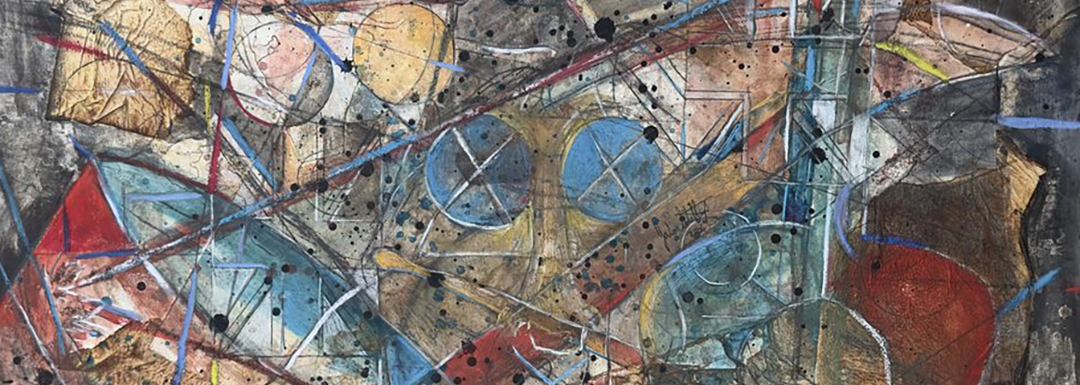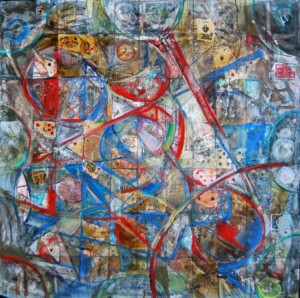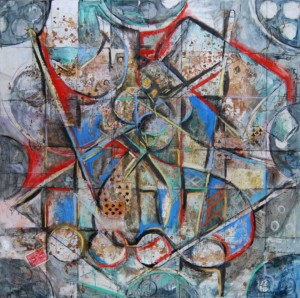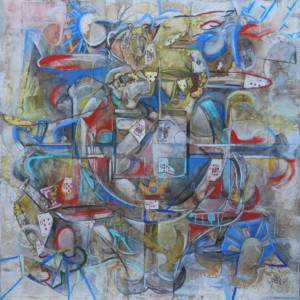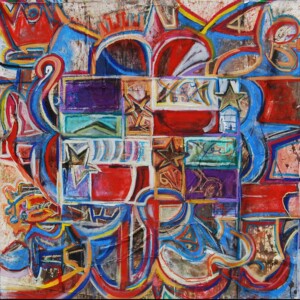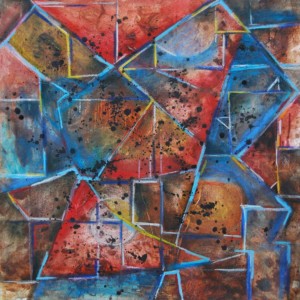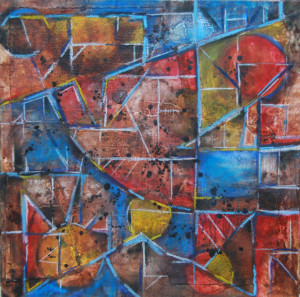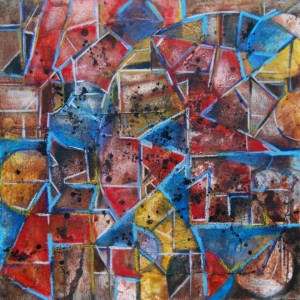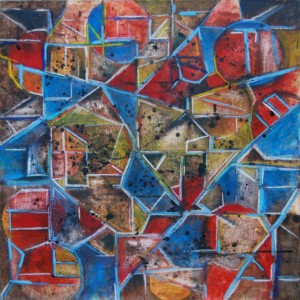My artistic interpretation of organized chaos
As an artist, I find inspiration in many forms of art. In college I explored design and studied gestalt principles in depth. I found the idea of exploring how the mind processes visuals to be fascinating. It has informed the way I think about approaching my art making either consciously or subconsciously quite a bit. This is also a painting that got me started on this path.
I’m also especially drawn to music, which often sparks my creativity and influences my work. One painting that was heavily influenced by music is “Can You See Me?” This painting was created in 2006, and it features a complex array of colors and shapes that together form an organized chaos. The title of this painting comes from a line in a song ‘Tommy can you see me? Can you feel me near you? Tommy can you see me? Can I help to cheer you?” by the Who. There is a whole running theme of experiencing heightened senses running throughout the album, and I found that very interesting studying, especially studying art, design, and gestalt.
How this resonated with me
One of the main characters in the story is lacking many basic motor functions, and is a ‘deaf, dumb, and blind’ “Pinball Wizard.” I will only speculate as to Pete Townsend’s motivations for writing this story, but there’s certainly a very extensive story to explore there. For my part, growing up with a host of learning differences, I found the idea of a young person overcoming personal challenges struck a deep personal chord with me. Add to that a need to find some way to balance in all of the information my young mind processed at once at that age.
What are Gestalt principles?
Gestalt principles refer to the ways in which our brains organize visual information into meaningful patterns and forms. These principles include ideas such as proximity, similarity, closure, and continuity. In “Can You See Me? these Gestalt principles are consciously or subconsciously explored through the use of overlapping shapes and colors to create a sense of movement and energy.
How I applied these concepts and Other influences
Completion and repetition where the most obvious concepts that were consciously applied in this case. I got interested in the idea of building an entire piece of art around a collection of half completed images. These partially completed images could either be read as the intended image or a collection of ideas that tested the idea of a whole image being a collection of the sum of its parts. Thus creating a repeated pattern of these ideas and you get a unique work as the final piece.
I also took subconscious influence from day dreaming in Sunday school as a kid being mesmerized by the transparent luminosity of church stained glass. Add to that being introduced to the art of Michael Tichansky and learning about how fractal mathematics works. Also it’s worth mentioning that in the Illustration program I was struggling to render simple images in a way that read immediately in a narrative sense. This is more of a requirement in a commercial setting, but moving against that in an opposing direction seemed to lead to a more successful path for me.
How this painting explores these principles
The piece utilizes the principle of continuity through the repetition of circular and linear forms, while the principle of similarity is seen in the use of analogous colors. The resulting composition invites the viewer to engage with the painting on both a visceral and cognitive level, as they interpret the various forms and shapes as a cohesive whole.
The song that exemplifies this influence on my art.
The inspiration for “Can You See Me?” came from The Who’s “Anyway, Anyhow, Anywhere.” Specifically, I was struck by the interplay between Keith Moon’s chaotic, rhythmic drumming and Pete Townshend’s more structured approach. I wanted to capture this dynamic in my painting, using color and form to create something that was both chaotic and cohesive at the same time.
The Who’s influences
Pete Townshend, the legendary guitarist and songwriter of The Who, was heavily influenced by blues and jazz music. He was particularly drawn to the raw emotion and improvisation of blues music, and he often incorporated blues-inspired riffs and melodies into his own compositions. In addition, Townshend was influenced by jazz musicians like John Coltrane and Charlie Parker, and he experimented with jazz chord progressions and improvisation techniques in his playing. Overall, Townshend’s blues and jazz influences helped to shape his unique style and contributed to the sound of The Who, one of the most iconic rock bands of all time.
speaking of Jazz Influences, I took a lot of influence from John Coltrane’s ‘A Love Supreme.’
“A Love Supreme” is a jazz album by legendary saxophonist John Coltrane, released in 1965. It is widely regarded as a masterpiece of the jazz genre and one of Coltrane’s greatest works. The album is a four-part suite that explores Coltrane’s spiritual beliefs and his quest for a deeper connection with the divine.
The recording of “A Love Supreme” was a significant moment in jazz history, as it marked a departure from Coltrane’s earlier, more conventional recordings and introduced a new style that came to be known as “free jazz.” The musicians involved in the album, including McCoy Tyner on piano, Jimmy Garrison on bass, and Elvin Jones on drums, were all highly skilled jazz musicians who contributed to the album’s innovative sound.
How the album was recorded
The album was recorded in one session, and Coltrane’s use of repetitive and circular motifs, as well as his explorations of rhythm and texture, create a hypnotic and transcendent listening experience. The album’s spiritual themes and use of call-and-response patterns also reflect Coltrane’s interest in African-American gospel music.
How I achieved this interpretation through my art.
To achieve this, I used a variety of colors and shapes, layering them on top of each other to create a sense of depth and complexity. Some areas of the painting are more structured and orderly, while others are more chaotic and unpredictable. The end result is a painting that feels like it’s in motion, with different elements vying for attention but ultimately coming together to form a cohesive whole.
Mixed media approaches I interpreted from CF Payne
In my Materials and Techniques courses under Professor Don Rodgers, I studied a mixed media technique created by artist CF Payne. As you can see by the examples in his work, the results are drastically different. After setting up a series of drawings to establish an armature, a thin layer of acrylic was applied to set a color scheme to follow. The basic ideas of then applying layers of transparency and utilizing a layer of thinned out black oil paint that you could erase to get instant lights and darks really appealed to me. I have since replaced this oil layer with water soluble graphite, which has a similar effect. The top layer in Payne’s pieces is in colored pencil to articulate details. I did use colored pencil in this painting but I have not revisited that much since.
The class that inspired this creative direction
I created this painting under the guidance of Professor Joy Flynn in my Drawing 3 class at SCAD. I began by tearing sections of high quality drawing paper and gluing them on a canvas with PH neutral glue at the local art shop Ex Libris in Savannah. I accidentally purchased the paper at the incorrect size. I then brewed a pot of thick, dark coffee at 3 in the morning following work at an late night pizza joint I worked at in college called Sweet Melissas. My roommate at the time, Eric, woke up extremely annoyed to see a puddle of dark coffee sitting on the floor on a canvas in our apartment. Understandable.
I have since replaced the paper with Qor watercolor ground and I use high flow acrylic paints in various colors with a water spritzer to get a similar effect. I do admit there’s a special type of patina that coffee offers that is difficult to replicate.
Final steps in the process
From here, I took my approach a step further by using some light sand paper to naturally ‘erase’ some areas to get some dynamics in rendering and texture. I would then apply soft and oil pastels in specific areas to articulate color and lines. By this point the intuitive nature of my mark making took over.
This led to my first art commissions
After “Can You See Me?” I continued to explore similar themes in my work. In 2008, I created “Puzzle and Games 1,” and “Puzzles and Games 2” which revisits many of the same colors and shapes from “Can You See Me?” but in a more structured and orderly way. This painting feels more contained and controlled than its predecessor, but there’s still a sense of movement and energy that ties it back to “Anyway, Anyhow, Anywhere.” I was later approached by the same client to create paintings in the form of “Road to Rhodes”, and “Lions and Tigers.” All of these paintings utilized some iconographic references to the lives of the client’s family members and acted as ‘abstracted portraits.’ My painting Sunflower was also part of the same commission as Lions and Tigers but it represented a pretty start departure stylistically.
Revisiting this approach and visual motif later in a subsequent commission
In 2017, I created a series of commissioned abstract paintings which continue to explore the themes of organized chaos and interplay between structure and chaos. Each painting in the series features a square shape that’s been broken down and reassembled in different ways, creating a sense of tension and movement. The colors in these paintings are bold and vibrant, with different hues competing for attention but ultimately working together to create a cohesive image.
Calling back to this painting in my 2020 commissioned painting ‘Gimme Shelter.’
When I created “Gimme Shelter,” I aimed to produce a painting with a visually complex composition of swirling lines and vibrant colors. The artwork depicts a sense of chaos and movement, with overlapping shapes and forms creating a dynamic and energetic visual experience. Visually, the painting can be compared to my earlier work “Can You See Me?” as a call back to its similar use of organized chaos. The two pieces share a similar use of overlapping shapes and colors to create a sense of movement and energy. However, “Gimme Shelter” takes this idea a step further by incorporating more intricate details and a greater range of colors to produce a more complex visual experience. I have a more in depth article on this painting and it’s history here.
Overall, my work is heavily influenced by music, and I often find myself drawn to artists who explore similar themes of structure, chaos, and interplay. Whether I’m creating a painting or listening to a song, I’m always looking for ways to capture that sense of energy and motion that comes from these complex relationships.
Do I still think of art in terms of gestalt improvisation?
Somewhat. It’s often said that all artist apply these principles in some way or another. My approach to art making has evolved somewhat as my needs and visual lexicon has grown. I certainly explore new ideas, but these principles will always be a guiding compass.


